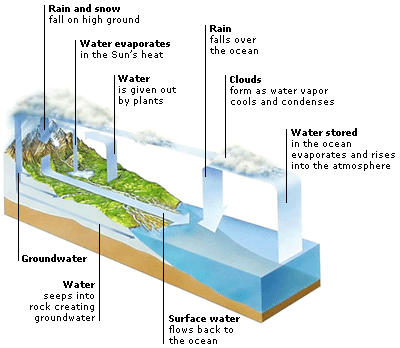DK Earth: Rain
Earth is unusual among the planets in our Solar System in having an atmosphere that contains moisture. Moisture in the air gathers in CLOUDS and eventually falls as SNOW, HAIL, sleet, or rain. Any kind of falling moisture is called precipitation.
The Sun’s heat causes moisture from oceans and lakes to evaporate into the air, forming water vapor. The vapor rises, cools, and condenses (turns into a liquid) into tiny water droplets, which form clouds. If the clouds continue to absorb moisture, they become saturated. The water droplets in the clouds collide and become bigger and heavier until the air can no longer support them. Then they fall as rain.
Around the world, rainfall patterns vary widely. In some regions, rain falls almost daily. In deserts, it may not rain for years. The tropics are generally wet, while the polar regions are dry because moisture there is locked up in the form of ice.
The water on Earth is constantly recycled between the oceans, land, and atmosphere. The water cycle, or hydrological cycle, is driven by the Sun’s heat. Life-giving rain feeds streams, rivers, and lakes. It waters plants so they can grow, and gives animals and people vital moisture.
Clouds are visible masses of moisture, made up of tiny ice crystals or water droplets, which are so light that they float. Clouds form in the troposphere (the lowest layer of Earth’s atmosphere) when water vapor rising high into the sky cools and condenses.
When the Sun shines on seas and lakes, some of the water in them evaporates into the warm air. If air currents blow the warm air over land and it rises over mountains, or if cold air pushes beneath the warm air and forces it upward, then the warm air cools. Cold air cannot hold as much moisture as warm air, so the water vapor condenses to form clouds.
The way clouds form depends on their height above the ground and on the movement of air. Wispy cirrus clouds form high in the troposphere. They are made of ice crystals drawn into strands by the wind. Rapidly rising pockets of warm air cause fluffy, mid-level cumulus clouds to form. Low-lying stratus clouds are formed by air that rises slowly over a large area.
Snow falls in cold weather when ice crystals formed high in clouds freeze together and drop to the ground as millions of tiny snowflakes. Sleet is a mixture of rain and snow, or partly melted snow.
Snow forms in clouds high in the atmosphere, where it is so cold that water droplets freeze into ice crystals. The ice crystals collide and stick together to make bigger crystals. When the crystals get too heavy to float, they fall to the ground as snowflakes. When snow falls, the air is just cold enough to let the flakes drift to the ground before they melt.
Hailstones are ice pellets that grow from ice crystals formed in freezing storm clouds and then plummet to the ground. Large hailstones can shatter glass, dent car roofs, and ruin crops.
Hail forms in cumulonimbus (storm) clouds that contain powerful, vertical air currents. Water droplets in the clouds freeze and are whirled up and down. Each time a hailstone is tossed upward to the frozen cloudtop, a new layer of ice forms around it. The ice builds up, layer by layer, until the hailstone becomes too heavy to remain airborne and falls to earth.



